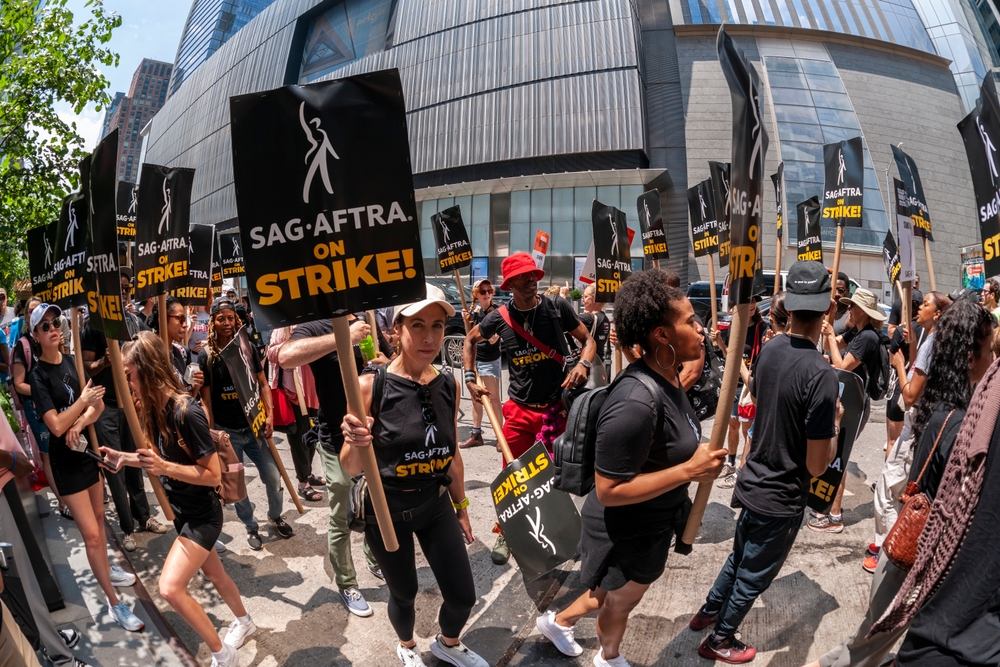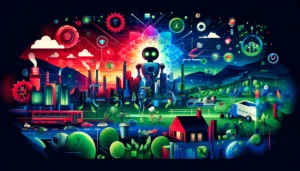Pay someone once and have them work forever – that is the peak of efficiency.
And that’s precisely what the Alliance of Motion Picture and Television Producers (AMPTP) is gunning for amidst the Hollywood strikes.
In the eyes of studio executives, AI presents an irresistible opportunity. After all, if technology can reproduce actors’ performances so precisely, then why bear the cost of employing them at all?
With a single payment for a ‘digital likeness,’ actors – humans – become obsolete, replaced by digital facsimiles that require no rest, make no demands, and hold no union cards.
Representing the likes of Netflix, Disney, and major US news networks, the AMPTP is one of the world’s strongest and richest industry alliances.
As for Hollywood’s unions, The Screen Actors Guild (SAG) was founded in the depths of the Great Depression when studios began employing ‘efficiency specialists’ to cut wages and extract more mileage out of directors, actors, writers, and other creators. It merged with the American Federation of Television and Radio Artists (AFTRA) in 2012.
The same now as it was back then, ‘efficiency’ has become a codeword for greed and a falsehood by which we judge our productivity.
Cost-cutting drives value for stakeholders when pressures restrict productivity, but outside pressures are typically temporary, whereas the impacts of cutting costs are often permanent.
Hollywood’s conflict revolves around the disconnect between the gatekeepers of the industry’s wealth and the actors and artists that keep its cogs turning.
Disney CEO Bob Iger said of the strikes, “It’s very disturbing to me. We’ve talked about disruptive forces on this business and all the challenges we’re facing, the recovery from COVID which is ongoing, it’s not completely back. This is the worst time in the world to add to that disruption.”
He continued, “There’s a level of expectation that they have, that is just not realistic. And they are adding to the set of the challenges that this business is already facing that is, quite frankly, very disruptive.”
The SAG-AFTRA president Fran Drescher retorted, “I cannot believe it, quite frankly: How far apart we are on so many things. How [the studios] plead poverty, that they’re losing money left and right when giving hundreds of millions of dollars to their CEOs. It is disgusting. Shame on them.”
And therein lies the void in opinion and intent that fuels unionization in the first place.
The challenge faced by SAG-AFTRA and WGA is that Iger and other studio executives have the money and power to drag this out to the very bitter end, and they know it.
One anonymous executive even went as far as to say, “The endgame is to allow things to drag on until union members start losing their houses.”
Ron Perlman fired back in a since-deleted Instagram video, saying, “There’s a lot of ways to lose your house. One of them is figuring out who the **** said that. And where he ****** lives.”
That’s fighting talk, and not the for the first time, Hollywood has become a cultural battleground.
AI-powered efficiency threatens creativity – but it’s our decision to make
We need to rethink ‘efficiency’ in the world of AI, as it’s perhaps not the panacea for growth we perceive it to be.
In corporate environments, efficiency is sometimes viewed as a problematic buzzword antithetical to the creative process.
Creativity is inefficient – it’s iterative and unpredictable – you can’t invent something new without failing several times in the process. Efficiency happens later, way after the initial brainstorming and genesis of ideas.
In his 2001 book “Slack: Getting Past Burnout, Busywork, and the Myth of Total Efficiency,” Tom DeMarco, a leading management consultant to Fortune 500 companies, explained why efficiency efforts can slow a company down.
He argues a case for ‘slack,’ a degree of freedom that enables creativity to flourish and generate productivity. In his words, “Slack allows for change, fosters creativity, promotes quality, and, above all, produces growth,” and “It’s possible to make an organization more efficient without making it better. That’s what happens when you drive out slack.”
In the context of the creative industries, AI has changed the nature of efficiency by replicating creative processes and wrapping them up in a digital interface.
Consider ChatGPT – it’s learned from millions of books, essays, and other pieces of human work to reproduce their methods and export them as a formula.
The same can be said for image generators like MidJourney and Stable Diffusion, which learn from human artwork to generate new pieces which are fundamentally derivative, despite looking superficially spectacular.
It’s also worth mentioning that complex AI architectures, like neural networks, are modeled by analogy to the human brain. AI learns from human information and emulates human decision-making.
The situation in Hollywood draws upon AI’s ability to replace intricate creative processes. Advanced AIs can simply copy a proven formula – like Tom Cruise’s power-packed stunts or Morgan Freeman’s timeless voice – and repackage it for reuse at will.
Rather than employing new actors, you’d simply dig into a database and choose from a digital lineup, like characters for a video game.
Alienating virtually everyone that made Hollywood’s film and TV industry what it is today is a high-risk strategy, especially considering Hollywood studios have been ‘de-risking’ in recent years.
Businesses across numerous sectors must ask whether AI’s short-term efficiency boost is worth the consequences. There will be a backlash, and I wonder – I hope – that authentic human contributions will, directly and indirectly, create value for those who embrace them.
It’s possible that those that continue to invest in human creativity will distinguish themselves from their AI-driven competition by simply doing what they were doing before AI was an option.
That might be wishful thinking, but the early signs are positive. For instance, Marvel incorporated AI-generated credits into their latest show Secret Invasion and was subsequently blasted for it on social media.
Similarly, in the new Black Mirror episode “Joan Is Awful,” Hollywood star Salma Hayek reacts to her digital likeness being used by a production company without her knowledge, the instinctual reaction among most viewers being something along the lines of ‘That’s messed up.’
Yes, Netflix, which belongs to AMPTP, owns the rights to the show – fate loves irony.
Hollywood’s unions aren’t marching against the grain – people seem to be learning to identify when AI is misused and are siding against it.
That isn’t about shunning AI’s role in the arts entirely but about upholding the sovereignty of the creative process and its intrinsic value. AI and human creativity are compatible if we want them to be, but they’re not mixing well right now.
In the end, debates over AI’s influence over the creative industries is a test, the first of many.
Hollywood is its ground zero.





